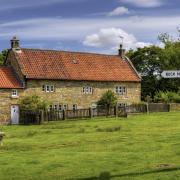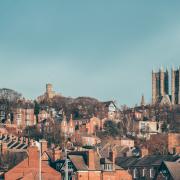Doncaster values its past but has its sights firmly set on the future Words and Photographs by Bill Hearld
Most people skipping along the streets of Doncaster in search of bargains are blissfully unaware of the rich history beneath and above them.
The town has played an important role in most periods of history since the first century AD, but it is also a town determined to have an exciting, vibrant future.
It all started when the Romans stumbled across it on their march northwards on what was later to become the Great North Road, now the A1.
Its strategic location on the River Don was ideal, making it the best fording point for miles around, and the river has played a key role in Doncaster’s prosperity ever since.
The Romans settled in the town, which they called Danum, in AD 71 and built a large fort there. A small section of the Roman wall from the fortification remains and can still be seen from within the grounds of Doncaster Minster.
King Richard I, the Lionheart, granted Doncaster its first charter in 1194, followed by a royal markets charter in 1248 - and they’ve been busy selling and buying in the same historic market ever since.
Its position on the Great North Road meant coaching inns flourished and many still survive, with inviting archways to courtyards beyond.
Horse racing has also flourished in Doncaster since the 18th century, starting with the Doncaster Cup, first run in 1766 and now the oldest regulated horserace in the world. Just 10 years later in 1776, the world famous St Leger Stakes, the oldest classic horse race in the world, was run for the first time. It still brings in 60,000 visitors every year, giving a festival atmosphere to the town each September.
Increased wealth meant a great many fine buildings were built during this time, including the 18th century Mansion House, one of only three surviving examples left in England.
With the industrial revolution, Doncaster’s central position and river and road connections ensured continued prosperity, as did its rich coal seams and the building of the north-south railway.
The Doncaster Works was established in 1853 by the Great Northern Railway and was to turn out many of the world’s finest steam trains, including the Flying Scotsman and Mallard.
Colin Joy is the town’s tourism manager and is charged with selling the town to hundreds of thousands of visitors every year. He says that much of its Roman history is still hidden tantalisingly beneath the streets. But if you look up above the modern shop fronts, you can still see the fine Georgian buildings that graced the town.
‘Our Roman heritage is still down there under the streets and one day it will be revealed as the town is redeveloped,’ he said.
Colin reckons his job is easy because modern Doncaster has so much to offer. And the figures back him up. Income from tourism and visitors was around �285 million last year, 18 per cent up on the previous year.
One of the town’s big draws is its market, which was recently named Britain’s Best Market 2011 because of its fantastic fruit and veg, fish and meat markets, the variety of outdoor traders and its antique and farmers markets.
But the town has a kaleidoscopic array of other shops, bars and restaurants too, which are packed every year during St Leger Festival Week with revellers drawn in by its music, fashion and fairs.
Now, the Metropolitan Borough of Doncaster has put in a bid for city status - many say it is already a city in everything but name - to give the place an economic boost. And work has started on Doncaster’s new performance venue and public square as part of the town’s Civic and Cultural Quarter project.
The project will revitalise Waterdale retail centre and will include the building of new civic offices which will become the council’s new headquarters.
It is all part of the new face of Doncaster, leaving its historic roots buried even deeper.
Dr Brian Barber was Doncaster’s principal archivist for 22 years and has written a definitive history of the town. His beautifully illustrated book, A History of Doncaster, chronicles the last 2,000 years, through poverty and plague in the Middle Ages, civil war, right up to and including the recent Donnygate council scandal.
He regrets the loss of most of the town’s physical history: ‘There is still the very grand Mansion House and if you look above eye level you can see the once-fine Georgian buildings in the town centre.
‘Doncaster has a very rich history and there remains some of it in the spine that runs from the racecourse to the Mansion House. But very little of the physical heritage remains to be seen. There is not much you can do about it, apart from making people aware.’
And that’s where his book and Colin Joy’s tourism department can help.
Getting there: Doncaster is in South Yorkshire on the A1M and M18 motorways and within 20 minutes of the M1 and M62. It’s on the main London-Edinburgh rail line and is seven miles from Robin Hood Airport.
Where to park: There are plenty of municipal car parks and spaces in shopping centre car parks.
What to do: Doncaster has several shopping centres and the best market in Britain. There are also museums, stately homes, the racecourse, Yorkshire Wildlife Park and Doncaster Dome sports complex.
What do you think of the plan to make Doncaster a city? Send your views to feedback@yorkshirelife.co.uk or leave a comment below


























